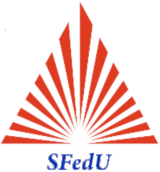Konstantin Nadolin
+7(863) 297-52-85
Associate Professor
Institute of Mathematics, Mechanics, and Computer Science named after of I.I. Vorovich

Research interests:
Mathematical modelling. Experience in developing and implementing course modules in this subject area. Coordinator of international double diploma MS programme. Experience in international curriculum development projects. Experience in international relations. Member in GAMM. Supervisor of many Diploma and Master thesis and several PhD projects. Member of the Faculty Board.
Teaching:
-
Modern numerical methods in mathematical modelling
Module is focused on boundary-value problems (BVP) for ordinary differential equations and partial differential equations (ODE and PDE) and is dedicated to the overview of modern numerical methods for computer-based solutions of BVP for ODE and PDE. The aims of the module are to produce the ideas of different numerical methods, analyses of their distinctive features and comparison of their effectiveness for applications. While the major emphasis is on the study of finite element method (FEM) because of its well-structured computer-oriented scheme, universality, and adaptability for 2D and 3D problems in domains with complicated geometry, the module also draws attention to finite difference method (FDM) and some popular Galerkin-based techniques: Bubnov method; method of moments; method of least squares; collocation methods (single and multiple collocation points, collocation in cells), etc. Also module includes discussions and analysis of programming tricks and coding techniques in MATLAB and C++ for the efficient numerical solution of problems in computational mechanics and biomechanics.
On successful completion of the module, students are expected to be able to:
• analyze different approaches to the discretization procedure for the typical BVP for ODE and PDE in terms of error estimation and algorithmic complexity;
• apply a suitable numerical method for given regular second order BVP for ODE and PDE by the weighted residual approach;
• ascertain basic properties of given regular second order BVP for ODE and PDE in differential and discrete form and discuss their relations on the base of problems apriory information;
• define and compare the calculations errors (both absolute and relative) for given regular second order BVP for ODE and PDE numerically and theoretically;
• use math packages (MATLAB, Maple etc.) for programming regular numerical algorithms of the typical BVP for ODE and PDE.
• demonstrate within laboratory work and individual project preparation the analysis and synthesis with learning resources and solving problems;
Role of mathematical modeling and computational experiment in natural science and engineering. ODE and PDE as mathematical models in mechanics and biomechanics. Fundamental PDEs, its classi-fication and basic initial and boundary-value problems. Basic formulas for differential operators, their characteristics and transformations. Operator representation for problems of mathematical physics.
Exact solution of PDE. Green operator and its representation as series or integral. Numerical solution of PDE vs. its classical exact solution. Dirichlet and Neumann problems for Poisson equation in regular domains. Numerical (MATLAB, Maple) and analytical (Fourier technique and variables splitting) approaches.
Galerkin-type approximation for operator equation (projection approach). Relations between residual of equation and error of approximate solution. Inner, boundary and overall residuals. Numerical methods classification on the base of residual.
Analysis of weighted residual methods (Bubnov method; method of moments; method of least squares; collocation methods (single and multiple collocation points, collocation in cells); finite difference method). Testing a set of weighted residual methods for second order ODE on segment.
Elliptic problems: classic, generalized and weak solutions for boundary-value problems. 3D, 2D and 1D examples. Essential and natural boundary conditions. Testing a set of weighted residual methods for second order PDE in rectangle (2D boundary-value problem).
FEM in 2D: domain triangulation; linear triangle finite element; shape functions; bilinear quadrangle finite element. Stiffness matrix and load vector (global and local level). Stiffness matrix for inner and border elements.
Example: Dirichlet problem for Poisson equation in square. Assembling procedure. Essential boundary conditions processing. Nodes numeration problem. Testing a second order PDE in rectangle (2D boundary-value problem) by FEM.
High-order finite elements. Lagrangian and Hermitian finite elements.
-
Seminar IT in Engineering
Module gives an introduction to autonomous research work by carrying out workshops from different fields of applied mathematics focused in mechanics and biomechanics.
On successful completion of the module, the students are expected to be able to:
• prepare and give scientific presentations by using modern computer tools;
• present the report on the obtained results orally in an understandable manner, observing general rules for scientific reporting;
• demonstrate knowledge regarding the area of study and related professions from the discussion in the Seminars on IT in Engineering;
• demonstrate capacity for research and abilities to search, process and analyze the information from a variety of sources;
• show within class attending activity and through extended project work preparation and presentation the ability to work autonomously
The module works in a seminar form. Each student receives a project work topic and presents the problem as well as the work plan at the beginning. Typically, the topics cover modeling problems from different scientific and engineering fields are focusing in mechanics and biomechanics, along with numerical solutions. Solution methods for the project work problems are discussed during the module. As a conclusion, the participants present their project works. The project work typically is an introduction to the diploma work topic of the student. Its suitable also for postgraduate studies as joint seminar sessions or conference presentations.



